|
Muzzle Blasts Online |
|
...for the muzzleloading enthusiast |
|
The muzzleblasts.com domain, subdomains, content, etc., are neither affiliated with the NMLRA nor its paper magazine Muzzle Blasts |
|
Muzzle Blasts Online |
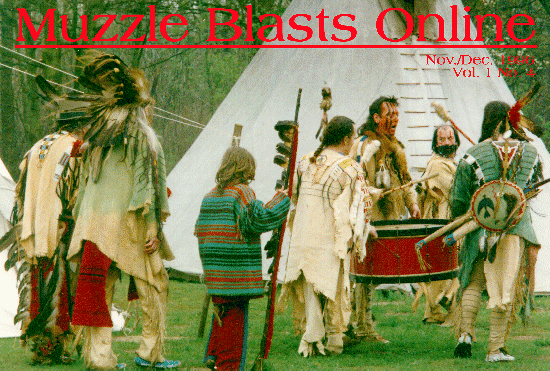
|
|
|
|
|
|
Buckskinning in Belgium

|
Scene 2: A crackling campfire throws its flickering light upon a circle of familiar faces. Jugs and bottles are passed around, there is laughter, jokes, and tales are exchanged. In the neighboring lodge, a guitar and a banjo try to out do each other in a joyful battle, and under a tree, two guys in buckskins try to convince each other that they each offered the other one a good trade.
Scene 3: Although the moon is high already, the Indian camp circle is still full of life. Two big drums are beating, bone whistles blown, the eerie voices of the female singers alternate with the powerful melodies sung by the warriors. The dance lodge is filled with fantastic moving shadows shuffling around on the beat of the drums, arm and leg bells jingling, rattles shaking.

|
Scene 5: An icy mist has covered the grass and trees with a white blanket. The outside temperature hovers around minus 10 (Celsius that's around 12 Fahrenheit). Three lean-tos have been placed with their openings faced to each other, forming a little square porch now covered and closed with tarpaulins and containing a roaring woodstove. Inside this canvas castle, it is warm and cozy and we can sit around in shirt sleeves (although the back walls have frozen solidly to the ground because of condensation water running off). It is New Year's Eve.
Scenes like these most probably sound familiar.... They could have happened a hundred and fifty years ago, somewhere on the Popo Agie or even earlier, somewhere in the Pennsylvania woods. Or they could be scenes of one or the other rendezvous like the Big Eastern, or the Western National, or from anywhere in America where present day buckskinners congregate. Yet they are not; these are glimpses of rendezvous in Belgium.
Buckskinning in Belgium
Oh yes, you can find buckskinners, blackpowder shooting, reenactors, camps, councils, pow wows, and rendezvous in Belgium. We even have two small buffalo herds!
As I am convinced that the majority of Muzzle Blasts readers are quite familiar with the sights, the sounds, and the smells of rendezvous, there seems little point in describing them. Others have done and still do this much better than I ever could. Instead, I thought it might be more interesting to dwell a little on what makes ``ours'' different from ``yours.''
A confession by way of introduction
I must confess however, that I have not been able (yet) to visit any real rendezvous in America. I have gathered my knowledge about these events by reading Muzzle Blasts, the Books of Buckskinning, etc., and by visiting the Friendship Primitive Range five times. Although this gave me a pretty good picture, it may be that some of the comparisons or statements I make are not entirely correct for which I apologize in advance.
If it's Tuesday, this must be Belgium
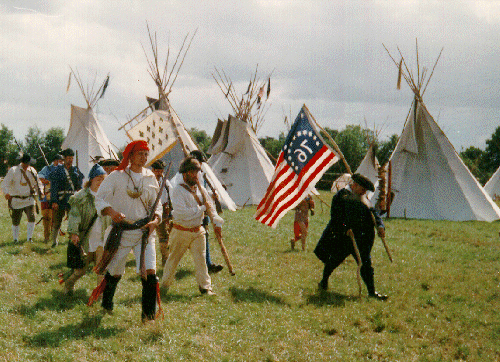
|
And all too often there is a high power line disfiguring the view of the woods bordering the camp, an ugly concrete stable, or some houses peeking through the trees, and a highway not far off humming all night.
In any case, there are camps and rendezvous and one annual national council organized by the Western Association of Belgium (WAB). This rather loosely knit association includes most of the local clubs having an active interest in living history. This encompasses not only mountainmen, fur traders, and Indians, but also Independence and Civil War enthusiasts, cowboys, Mexicans, buffalo hunters, French voyagers, etc.
Judging by the number of people who participated in the last national council in August, 1995, there are about 400 more or less active Belgian members in the WAB. Many more people are involved in the hobby, as there also are several splinter groups, small informal clubs, and individuals who for reasons of their own, have split up or don't want to fall in with an association like the WAB probably also a phenomenon familiar to the American buckskinning scene.
Period and culture mix
Probably the most specific aspect of rendezvousing in Belgium is that we have no strictly applied ``pre 1840'' rule. I am sure that there must be other living history movements in the USA covering other fields than ``pre 1840.'' I know that for Civil War enthusiasts, there is the NSSA, and although I don't know them, I am sure there must be other clubs or associations dealing with other aspects of Americana such as cowboy life, buffalo hunters, specific Indian reenacting, etc.
In any case, rather peculiar to a Belgian ``council'' is that you can find Texas Rangers camped next to a bunch of mountain men; or a Union Cavalry unit as neighbors to some Roger's Rangers; New Mexican buffalo hunters in the vicinity of the Plains Indian camp circle; and cowboys fraternizing with Iroquois scouts to a Hudson Bay trading post.
This sort of period and culture mix applies only to bigger national councils or rendezvous. Apart from these, all subgroups have their own smaller camps devoted to one theme, time period, and/or one area.
Wooden Moccasins
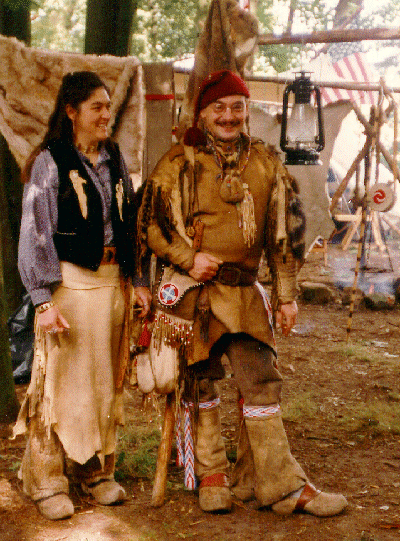
|
|
Clay Basket with husband Cuisteau (on wooden moccasins!) |
Of course there were clogs in rural 19th century America. Flemish and Dutch pioneers and settlers brought them from the home country. They were also manufactured on a small scale in Michigan, Illinois, and Iowa. Historically they are correct, but one can hardly imagine John Colter stomping around in the Rockies on such wooden shoes. Still, although somewhat out of place, they seem to be generally accepted. Clogs have a definite ``old time charm,'' and no other footwear can beat our wooden moccasins for convenience and practicality. Your feet keep dry and warm when you slosh around in the mud or wade through tall wet grass, and our climate being what it is, mud and moisture are always present in camp. Wooden shoes also isolate fairly well on frozen ground. They don't wear or tear, and you simply step in and out of them when leaving or entering your lodge.
Strong Indian presence
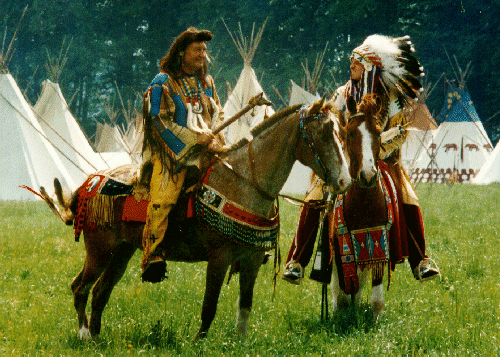
|
The great majority does not stop at simply wearing historically accurate clothing. There is a true tribal organization with strict rules enforced by a Kit Fox or Dog Soldier society. Proper ceremonies with correct songs, dances, sweat lodge, and pipe smoking rites and correct behavior towards ``whites,'' Mother Earth, and nature are enforced. The way in which these people not only jump back in time and space, but embrace a completely different culture is astonishing.
Even during national councils, Indian camp circles are usually closed to non-indianist. Sometimes there is an ``open evening'' in their dance lodge, and every interested trapper or cowboy can come and watch the dancing. At times there is a ``peace palaver'' or even a pipe smoking with the whites, but as a general rule, the Indian and white reenactors live up to a spirit of mutual distrust and incomprehension, almost as strong as it was in times gone by on the Plains.
Across the borders
The small territory of Belgium was already mentioned, so it follows that local buckskinners and Indians do not confine themselves to that. There is a lot of ``across the borders'' movement, with Belgians participating in rendezvous in Holland, Germany, and France. In Belgian camps, one can always find several French, German, and Dutch brothers and sisters at times even English who crossed the Channel.
However strange it may sound, ``Western'' reenacting groups exist also in Eastern European countries. Most of these are Indian even as far away as Moscow. There is a small group of Russians acting as Assiniboin warriors! Because of limited funds to cover travel expenses, these people rarely visit Western European rendezvous on a regular basis, still they have appeared from time to time, mostly at German meetings.
Germany also has the greatest quantity of Western reenactors, and every year the ``Western Bunk'' organizes the biggest of all rendezvous in Europe. 1995 marked their 45th event.
Maybe to American standards this event is not so big, but when you see about 300 tipis in the Indian camp circle, with at least the same quantity of other lodges (lean-to's, military A-frames, etc.), I can assure you that it is a sight to behold. ``Mainstreet'' in this camp looks like a pioneer town. All of the traders set up shop there under big tents, but with a wooden facing. There is a Mexican cantina, a mountainman bar, and even a saloon and restaurant with a counter that is about 90 feet long. The opening ceremony in Dog City (Hundsdorf is the name of the little German town where it all happens) is something unforgettable.
Simultaneously, all participants congregate to the ``main square'': a long row of Indians beating drums and singing from the Indian camp circle; trappers and mountainmen with several bagpipes playing; and Union and Confederate military marching with fifes and drums.
Western Weekends in Holland
There are also several gatherings in our northern neighbor's country, but they cannot really be called rendezvous or councils. ``Western'' events in Holland are mainly centered around blackpowder shooting contests.
Blackpowder shooting
Mentioning the ``Western Weekends'' in Holland leads me to another sad particular point about Belgium. We have no open spaces where camping could be combined with shooting, and our arms legislation is rather strict so there is no blackpowder fun at our rendezvous or councils.
Many of our buckskinners are also blackpowder shooters, but that part of their hobby has to be carried out in an entirely different organization and in a different setting.
In Belgium and Europe in general we don't embrace the NMLRA idea that ``if it loads from the front, we support it.'' We prefer to think ``if it used blackpowder, we shoot it.'' This includes types of firearms banned from the Friendship shooting range European and Japanese matchlocks, all types of cartridge guns (paper as well as metal) the line is only drawn at those that historically used smokeless powder.
The only kind of ``shooting'' to be found on a rendezvous or council (apart from the occasional blank cannon shot at seven in the morning) is duelling with revolvers performed by cowboys and outlaws. For those who might think that blood is freely flowing at such occasions, a duel is shot out with blanks, on balloons suspended six to ten feet away.
Fun and Games
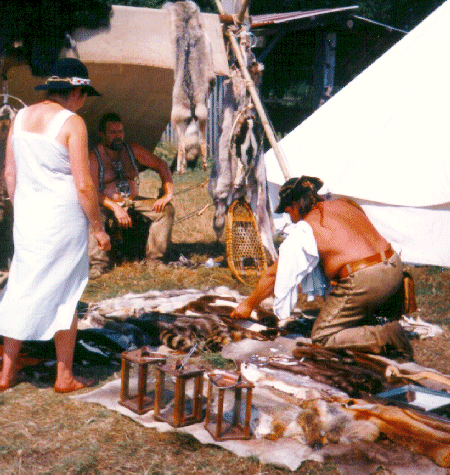
|
Battles can also be of a sportive nature. I witnessed a marvelous game of ``two ball'' at the Company of Free Trappers council in May. It pitted six Indians against six mountainmen and cowboys, each one with a nice heavy stick. There were no field limits and no playing rules to speak of, so pots and pans went flying every time the excited players crashed through someone's kitchen. The Indians lost by 6 to 1. Maybe the fact that they played barefoot on the grass and the whites were all in boots or heavy shoes had something to do with it it certainly accounted for a lot of bruised ankles and feet.
I have not been, but have heard great tales about the French National Rendezvous. In 1995, they had a theater, complete with candle footlights, the texts (Shakespeare!) of the parts being played were shown on big paper scrolls above the scene. One night, a couple of ``nuns'' visited the saloon and held a vigorous preach against the sinful practices of gambling, alcohol consumption, and the like which did not prevent them, some hours and several drinks later, from dancing the French Cancan on the tables!
An Unusual Camp by way of conclusion
I have just returned from my first camp of the year. It was held February 1618, in the southwest, close to the French border. The camp had several features unusual for Belgian conditions. The theme was an 1850 - 1880 ``Buffalo Hunters Camp,'' and was attended by about 35 people from Belgium, France, Holland, and Germany.

|
|
Cool sips always keep the conversation warm. |
Most unusual of all was that the organizers obtained special authorization to hold a shooting contest in the camp itself we each had five shots over crosssticks at buffalo targets. Even the weather was unusual, as during the shooting contest there was not a single drop of rain. We got the balance in wet snow and hail during the night and the next day.
Let's hope that there will be many more such unusual camps in the future!
Photo Credits: Corina & Lieven Allegaert (Cuisteau & Clay Basket), Jacques Diet (Flanel Jack), and Karl Ceurremans (Bear who Follows His Own Trail).
Readers interested in more information are encouraged to contact the author,
Karl Ceurremans, Lisperstraat 57, 2500 Lier, Belgium.